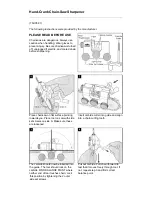
ST/STR/STA MANUAL
2
118107-001 REV J
easily turn the unit on and enable/disable the generation
of high voltage.
FRONT PANEL INDICATOR LAMPS:
CONTROL
POWER ON,
HIGH VOLTAGE OFF and HIGH
VOLTAGE ON indicators are integral with the control
switches and equipped with dual lamps for redundancy
and safety.
FRONT PANEL POTENTIOMETERS:
Ten turn
locking counting dials are provided for easy programming
of the desired voltage and current regulation values.
FRONT PANEL DIGITAL METERS:
3.5 digit meters
are provided to view the output voltage and current. A
convenient Preset View Feature is provided: If the HIGH
VOLTAGE OFF button is depressed and held in, the
present voltage and current programming values will be
displayed in actual kV and mA on the front panel meters.
ETHERNET AND RS-232 INTERFACE:
DSP based
SMT circuitry provides both Ethernet and RS-232 digital
interfacing capability simplifying the integration of the
ST into your system design. A VB GUI is provided for
the RS-232, the Ethernet has an imbedded applet for
control.
SLOW START RAMP TIME:
This feature provides a
gradual increase of high voltage until the preset operating
point is reached. The slow start time is factory set for ten
seconds. Other slow start times can be software
configured using the digital interface.
ARC QUENCH/ARC RERAMP/ARC TRIP:
These
features allow the user to tailor the power supply to meet
specific needs in dynamic load applications. The standard
configuration is if an arc occurs, the output is inhibited for
approximately 200mS (Arc Quench), and then the output
is ramped up to the preset level with the Slow Start
circuitry time constant (Arc ReRamp). If four arcs occur
in a ten second time period the unit will shut down
displaying an “ARC” Fault (Arc Trip). See Chapter 3 for
operating details and information for user customization
for these parameters via the software and the digital
interface.
INTERNAL FAULT PROTECTION:
The ST series
continually monitors internal circuits critical to the proper
operation of the power supply.
In the event that one of
these circuits malfunctions, the fault detection circuit
turns off the high voltage and reverts the unit to the
POWER DOWN mode with the CONTROL POWER ON
indicator lamp flashing ON/OFF slowly. The applicable
fault indicator will be illuminated on the front panel
requiring the user to clear (cycle the CONTROL POWER
ON switch, cycle the AC line power or toggle the
Reset/External Inhibit signal line).
OUTPUT CABLE:
All standard models are provided
with a ten foot shielded high voltage output cable. The
cable is designed so that it can be easily removed from the
mating receptacle located on the rear of the chassis.
1.2.1 Remote Operating Features
REMOTE
PROGRAMMING:
Allows
remote
adjustment of the output voltage, current, power and
overvoltage regulation parameters via the use of external
voltage sources.
REMOTE MONITOR:
Allows remote monitoring of
the output voltage, current and power test points.
REMOTE HIGH VOLTAGE CONTROL:
Allows
remote control of the HIGH VOLTAGE ON and HIGH
VOLTAGE OFF functions. Signals are also provided for
remote indication of HIGH VOLTAGE ON and HIGH
VOLTAGE OFF status.
REMOTE POWER ON:
Allows remote control of
CONTROL POWER ON/OFF function. This feature also
allows remote reset of the power supply in case of
SYSTEM FAULT shutdown.
RESET/EXTERNAL INHIBIT:
This circuit will reset
any latched power supply faults and inhibit the high
voltage output. A logic low/ground, will reset any fault(s)
while inhibiting the high voltage output. A logic
high/open will restore the high voltage output to the
preset level. NOTE: The External Inhibit circuit should
NOT be used for protection against injury or for safety
interlocking. See External Interlock for this type of safety
control.
EXTERNAL INTERLOCK:
Interlock connections are
provided on the rear panel interface connecter for
connection to a safety switch. The unit will not operate
unless the interlock circuit is closed. During high voltage
operation, opening the interlock circuit will cause the










































